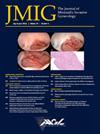在错误通道中导航:有效宫腔镜检查管理策略
IF 3.5
2区 医学
Q1 OBSTETRICS & GYNECOLOGY
引用次数: 0
摘要
研究目的 宫腔镜检查是诊断和治疗腔内子宫病变的金标准。宫腔镜检查很少出现并发症,但50%的并发症与宫腔进入有关。误入宫腔与早期手术终止或流产有关。设计这是一篇关于假通道诊断和处理的文献综述,并通过视频展示了宫腔镜下宫颈内桥分离的创新技术。患者或参与者两名接受宫腔镜检查的患者被诊断为假通道。干预措施诊断性宫腔镜检查、宫腔镜下剪刀宫颈桥分离术、宫颈水切割术和倾斜技术。第一例患者的特点是子宫前倾,采用宫腔积液和倾斜技术成功处理了后方假通道。第二个病例的特点是子宫后倾,通过宫腔镜剪刀进行宫颈内桥分离,有效地解决了前方假通道的问题。结论在宫颈扩张过程中出现假通道是一个多因素的挑战,有可能导致手术过早终止并引发子宫穿孔。缓解和处理这种并发症需要系统的方法。目前已探索出多种处理方法,其中宫腔镜下用剪刀分离宫颈桥是一种实用且易于操作的方法,有望减少宫腔镜手术的过早终止和相关流产率。本文章由计算机程序翻译,如有差异,请以英文原文为准。
Navigating False Passages: Strategies for Effective Hysteroscopy Management
Study Objective
Hysteroscopy represents the gold standard for diagnosing and treating intracavitary uterine pathology. It is rarely associated with complications, but 50% are related to uterine cavity entry. The false passage is correlated with early procedure termination or abortion. The objective is to educate about this pathology and to describe the different management techniques.
Design
This is a review of the literature on diagnosing and managing false passage and a video presentation of an innovative technique for hysteroscopic intracervical bridge division.
Setting
University-associated community hospital.
Patients or Participants
Two patients undergoing hysteroscopy were diagnosed with false passage.
Interventions
Diagnostic hysteroscopy, Hysteroscopic bridge division with scissors, hydrodissection, and tilt technique.
Measurements and Main Results
False passage was identified during diagnostic hysteroscopy in two patients. In the first case, characterized by an anteverted uterus, a posterior false passage was successfully managed using a combination of hydrodissection and the tilt technique. In the second case, featuring a retroverted uterus, an anterior false passage was effectively addressed through intracervical bridge division with hysteroscopic scissors. Notably, both procedures were completed as planned, showcasing the efficacy of the implemented techniques.
Conclusion
False passage during cervical dilation poses multifactorial challenges, potentially leading to premature procedure termination and concerns of uterine perforation. Mitigation and management of this complication require a systematic approach. Various techniques have been explored for its management, among which hysteroscopic division of the cervical bridge with scissors emerges as a practical and easily accessible strategy, offering promise in reducing early hysteroscopic termination and associated abortion rates.
求助全文
通过发布文献求助,成功后即可免费获取论文全文。
去求助
来源期刊
CiteScore
5.00
自引率
7.30%
发文量
272
审稿时长
37 days
期刊介绍:
The Journal of Minimally Invasive Gynecology, formerly titled The Journal of the American Association of Gynecologic Laparoscopists, is an international clinical forum for the exchange and dissemination of ideas, findings and techniques relevant to gynecologic endoscopy and other minimally invasive procedures. The Journal, which presents research, clinical opinions and case reports from the brightest minds in gynecologic surgery, is an authoritative source informing practicing physicians of the latest, cutting-edge developments occurring in this emerging field.

 求助内容:
求助内容: 应助结果提醒方式:
应助结果提醒方式:


